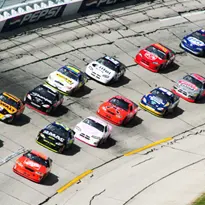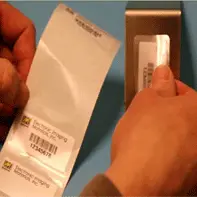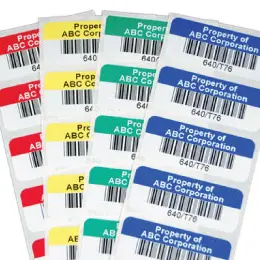There’s some misconception in barcode history that the retail UPC barcode was the very first barcode. Actually, the FIRST BARCODE SYMBOLOGY was round and wasn’t officially called a barcode when it was invented. It looked like a bull’s eye target because it was a series of concentric circles designed to be scanned from any direction; it came to be known as the Bulls-Eye Barcode. The design was developed by two college students, Joseph Woodland and Bernard Silver, when they recognized the need to track huge inventories in grocery stores that were starting to get bigger and bigger (aka supermarkets).
The Bulls-Eye Barcode
Woodland got a job at IBM in 1951 and convinced the company to hire a consultant to investigate barcodes. As he pondered supermarket needs, he first came up with an idea based on the Morse Code, but instead of dots and dashes he extended them into a series of broad and narrow lines… the first lineal barcode. Taking it a step further, they took the vertical pattern of lines and put them into a circle.
At the same time, they worked on developing a scanner that could read such codes and in 1952, they patented the Bull’s-Eye and its linear version along with the mechanical and electrical systems they created to read the codes. IBM offered to buy out their patent but didn’t think it was commercially viable yet and wouldn’t meet their price. Philco, on the other hand did, and eventually sold it to RCA. This was the beginning of a new age in electronics and automatic identification.

The Bulls-eye was not put into actual use until 1967 when RCA started promoting it to the grocery industry. A Kroger Grocery store volunteered to be the first guinea pig and RCA emphasized the huge savings to automate the checkout counter.
Unfortunately, while the Bulls-eye required less scanner orientation, the code took up a lot of space and the round format limited the amount of data that could be encoded. It never became popular because technology at the time was not able to do variable printing easily and scanners were just starting to be fine-tuned.
Railroads: The First Practical Application of Barcoding
As developers were ironing out the kinks and costs in scanning equipment and computer technology, advances in the auto ID industry took a different turn and focused on our railroad system that feeds the retail and manufacturing industries. As you can imagine, freight cars go from one end of the country to the other. They are also lent out from one rail line to another. Keeping track of them can be a nightmare.

It’s interesting to realize that the FIRST APPLICATION for barcodes involved our railroad system. In the late 1960’s, the Association of American Railroads (AAR) started using a system called KarTrak that was developed by a railroad employee and MIT graduate by the name of David Collins. The concept was based on using blue and red reflective stripes painted on steel plates that were riveted in various combinations on the sides of railroad cars. There were 13 horizontal labels on every plate and much like barcodes, had “start” labels, “stop” labels and check digits. The specific arrangement of the stripes encoded a 4-digit railroad company identifier and a 6-digit car number. As a railcar moved past a rail yard scanner, it would read that information.
Unfortunately, after about 10 years that program was abandoned because there was an economic downturn and the system was deemed unreliable and error-prone because of persistent dirt contamination. By the 1980s radio tags became far more popular in tracking railroad cars. Collins moved on to start a company called Computer Identics Corporation, recognizing other applications for barcodes, particularly in industrial settings. General Motors had one of the first plants to monitor the production and distribution of automobile parts with barcodes; another early system went to a distribution facility.
The First UPC Barcodes
So what happened to Woodland and Silver? Unfortunately, Bernard Silver died in 1963, at the early age of thirty-eight. If you will recall Joe Woodland was working for IBM. When the company started noticing all the attention RCA was getting with the Bulls-Eye Barcode, they remembered they had the inventor on their staff. Woodland went on to play a major role in the development of the most popular and important barcode of the time – the UPC (Universal Product Code.) In fact, he has been called the “Father of Barcodes.”
You may be familiar with the story about a 10-pack of Wrigley’s Juicy Fruit gum that was the very FIRST ITEM TO BE COMMERCIALLY SCANNED with a UPC barcode. This goes back to June of 1974 when the first grocery store checkout scanner was installed by the National Cash Register at Marsh’s Supermarket. This proved to be the turning point for acceptance of barcodes in the grocery industry and that same pack of gum became so famous it now resides in the Smithsonian Institution!
The UPC solved not only the check-out needs but also gave store owners a way to quickly monitor and maintain accurate inventory counts. Gone were the days of having to manually punch in an item’s SKU number and cost into the cash register. When the UPC was officially adopted in 1973, it helped standardize the retail industry, leading manufacturers to put the UPC right on their packages so the stores didn’t have to stop and transfer data. Who would think a pack of gum could become so important?




